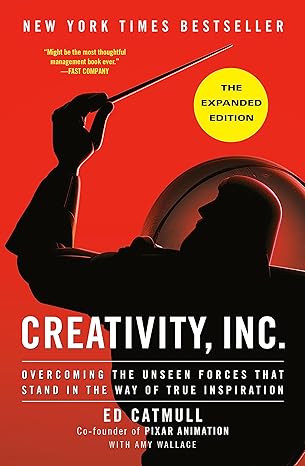
By: Ed Catmull
Creativity, Inc. is both a memoir of Pixar’s rise and a leadership guide for fostering creativity. Ed Catmull’s insights show that by prioritizing safety, feedback, adaptability, and innovation, leaders can build an environment where creativity thrives, leading to sustained success in any organization.
Frameworks and Strategies
1. Building a Creative Culture
- Importance: Creativity flourishes in an environment where people feel safe to share ideas and take risks without fear of failure.
- Steps to Implementation:
- Create a psychologically safe space where team members can speak freely.
- Foster collaboration by breaking down silos between departments.
- Encourage experimentation and accept failure as part of the creative process.
- Checklist:
- Does your team feel safe sharing ideas and feedback?
- Are you encouraging collaboration across disciplines?
- Do you treat failure as an opportunity to learn?
2. The Braintrust: Feedback Without Fear
- Importance: Honest, constructive feedback is essential for refining ideas and solving problems creatively.
- Steps to Implementation:
- Assemble a group of trusted individuals who can critique work without hierarchy.
- Focus on the problem, not the person, when giving feedback.
- Encourage diverse perspectives to challenge assumptions and biases.
- Checklist:
- Have you established a feedback mechanism like the Braintrust?
- Is feedback focused on improving the work, not criticizing individuals?
- Are you including diverse perspectives in discussions?
3. Embracing Uncertainty and Change
- Importance: Creativity involves navigating uncertainty and embracing change, which can be challenging for teams and leaders.
- Steps to Implementation:
- Accept that unknowns are a natural part of the creative process.
- Encourage teams to explore new ideas without fixating on a single solution.
- Stay flexible and adapt plans based on new insights or obstacles.
- Checklist:
- Are you and your team comfortable with uncertainty?
- Do you encourage exploration of multiple ideas before settling on one?
- Are you open to adapting strategies as circumstances evolve?
4. The Hidden Costs of Success
- Importance: Success can lead to complacency, groupthink, and risk aversion, which stifle creativity.
- Steps to Implementation:
- Continuously question assumptions, even when things are going well.
- Avoid over-reliance on past successes by encouraging innovation.
- Regularly revisit processes and practices to ensure they remain effective.
- Checklist:
- Are you actively questioning successful strategies to find areas for improvement?
- Are you encouraging innovation instead of relying on past successes?
- Are you reviewing processes to avoid stagnation?
5. Leadership as a Servant Role
- Importance: Leaders play a crucial role in enabling creativity by supporting their teams and removing obstacles.
- Steps to Implementation:
- Focus on empowering your team rather than controlling their work.
- Identify and eliminate barriers that hinder creative flow.
- Recognize and celebrate the contributions of all team members.
- Checklist:
- Are you empowering your team to make decisions?
- Are you addressing obstacles that prevent creativity?
- Are you acknowledging and rewarding contributions across the organization?
Final Checklist
- Foster a culture where feedback, experimentation, and collaboration thrive.
- Embrace uncertainty and encourage teams to explore multiple solutions.
- Actively challenge complacency and prioritize continuous improvement.
- Create feedback systems like the Braintrust to refine ideas constructively.
- Lead by empowering your team and removing obstacles to creativity.